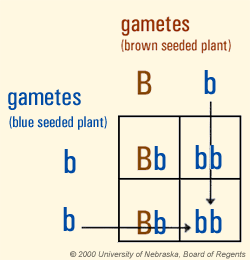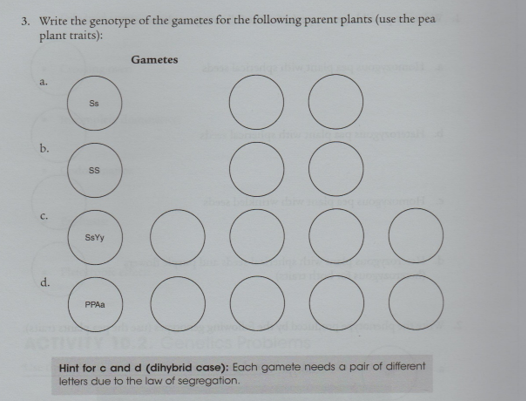
So how do you find genotypes? Sometimes genotypes may be given to you. Other times you may have to figure them out based on descriptive terms, like: homozygous dominant = big-big homozygous recessive = little-little heterozygous = big-little STEP 2: List all possible gametes (egg cells or sperm cells) each parent genotype can produce A: Each group of linked genes is composed of two groups of alleles, which are enclosed in round brackets, so you can simply write the name of the chromosome X or Y before a group of alleles. And in order to demonstrate the lack of genes in the Y - chromosome you must use the symbols "-" or "_" - for each lacking blogger.com size: Mb Referring to the table above, we have now deduced the genotypes of the test cross progeny. If we "subtract" the "red gamete (ab) from the tester parent, we are now left with the gametes produced by the unknown parent. In this case, the unknown parent made four gametes AB, Ab, aB and ab in a ratio
Genotypes to Gametes and Gametes to Genotypes
Accordingly, he proposed three laws: 1 Law of Dominance, 2 Law of Segregation, and 3 Law of Independent Assortment, collectively known as Laws of Inheritance. Among all, the law of independent assortment was discovered while performing dihybrid crosses between the pea plants.
A dihybrid cross is a breeding experiment involving two organisms that are identical hybrids for two traits or characters. A hybrid organism is heterozygous, which means it carries two alleles of a particular gene. Traits are characters determined by segments of DNA called genes. An allele is an alternative gene form inherited from each parent during sexual reproduction. A dihybrid cross determines the genotypic and phenotypic combination of offspring for two particular genes that are unlinked.
Here, the individuals are homozygous for a particular trait. One parent contains homozygous dominant alleles, while the other contains homozygous recessive alleles. The offspring, or F1 generation, formed after crossing the two parents is heterozygous for the specific traits being studied. Thus, all of the F1 individuals possess a hybrid genotype, expressing dominant phenotypes for each trait. He chose to cross a pea plant pair with two pairs of contrasting traits.
These traits are seed color and seed shape. One of the how to write genotypes for gametes is homozygous for the dominant traits of yellow seed color YY and round seed shape RR. Thus, together the genotype is expressed as YYRR.
The other plant is homozygous for the recessive traits of green seed color yy and wrinkled seed shape rr. Together the genotype is expressed as yyrr. A true-breeding pea plant with yellow seed color and round seed shape YYRR is cross-pollinated with another true-breeding plant with green seed color and wrinkled seed shape yyrr.
The resulting F1 generation is all found to be heterozygous for yellow seed color and round seed shape YyRr. All F1 offspring were found to be phenotypically identical, producing yellow seed color and round seed shape. Mendel continued with his experiment with the self- pollination of F1 progeny plants. To his surprise, the plants exhibited a phenotypic ratio of seed color and seed shape.
Nine out of the sixteen plants were found how to write genotypes for gametes exhibit round, how to write genotypes for gametes, yellow seeds. Three of them exhibited round green seeds. Another three gave wrinkled, yellow seeds, and the remaining one plant gave wrinkled green seeds.
Thus, F2 generation exhibited four different phenotypes and nine different genotypes. Genotypes determine the phenotype in an organism. Thus, a plant exhibits a specific phenotype based on whether its alleles are dominant or recessive. One dominant allele leads to a dominant phenotype being expressed, how to write genotypes for gametes.
The other way for a recessive phenotype to appear is for a genotype to possess two recessive alleles. Both homozygous and heterozygous dominant genotypes are expressed as dominant. In the experiment performed by Mendel, yellow Y and round R are dominant alleles, and green y and wrinkled r are recessive. The possible phenotypes and their genotypes are given below:. The above result is represented using a 4 x 4 Punnett square. All the four possible combinations of gametes for yellow seed color and round seed shape pea plant are placed from top to bottom of the first column, how to write genotypes for gametes.
For green seed color and wrinkled seed shape, pea plant how to write genotypes for gametes the top row from left to right. The Punnett square is given below:. His experiment with dihybrid crosses shows all the possible offspring that can come from two given parents. Crosses involving multiple traits also help us understand the type of inheritance pattern that governs each trait. It also works to determine a specific phenotypic ratio and how many offspring have a specific trait.
Dihybrid crosses gave rise to independent assortment law, which states that pairs of alleles are inherited independently if their loci are on separate chromosomes. In other words, the genes are unlinked.
It is a cross that helps to explore the genotype of an organism based on the offspring ratio. A dihybrid test cross is done involving two pairs of contrasting characters. In a test cross, an individual with an unknown genotype is crossed with a homozygous recessive individual.
The unknown genotype can be obtained by analyzing the phenotypes in the offspring. The result of a dihybrid test cross-ratio is represented using a Punnett square. Here, one of the heterozygous parents for seed color and seed shape RrYy is crossed with a homozygous plant for both the traits rryy. The test cross produces four possible genetic combinations RrYy, how to write genotypes for gametes, Rryy, rrYy, and rryy in a ratio of Article was last reviewed on Friday, February 5, Your email address will how to write genotypes for gametes be published.
Save my name, email, and website in this browser for the next time I comment. All rights reserved. Reproduction in whole or in part without permission is prohibited. Physics Why Does Water Expand When It Freezes Gold Foil Experiment Faraday Cage Oil Drop Experiment Magnetic Monopole Life Science Why Do Fireflies Light Up Types of Blood Cells With Their Structure, and Functions The Main Parts of a Plant With Their Functions Parts of a Flower With Their Structure and Functions Parts of a Leaf With Their Structure and Functions Chemistry Why Does Ice Float on Water Why Does Water Expand When It Freezes Why Does Oil Float on Water Geology How Do Clouds Form What Causes Lightning How are Diamonds Made Types of Meteorites Types of Volcanoes Types of Rocks Worksheets.
Dihybrid Cross. Signify each allele using characters. Capital letters are used for the dominant allele, lower case letters for the recessive allele. Write the genotype and phenotype of the parents P generation.
Always pair alleles for the same gene and write capital letters first and then small letters like AaBb. Write all potential gamete combinations for both parents. Use a Punnett square to work out potential genotypes of offspring. Include the different gamete combinations for each parent like AaBB has two combinations, AB and aB. Write the phenotype ratios of potential offspring.
F1 Generation A true-breeding pea plant with yellow seed color and round seed shape YYRR is cross-pollinated with another true-breeding plant with green seed color and wrinkled seed shape yyrr. F2 Generation Mendel continued with his experiment with the self- pollination of F1 progeny plants.
Genotypic and Phenotypic Ratios Genotypes determine the phenotype in an organism. The possible phenotypes and their genotypes are given below: Phenotypes Number of Plants Genotypes 1 Yellow and Round how to write genotypes for gametes YYRR, YYRr, YyRR, YyRr 2 Yellow and Wrinkled 3 YYrr, Yyrr 3 Green and Round 3 yyRR, yyRr 4 Green and Wrinkled 1 yyrr How to Make a Dihybrid Cross Punnett Square The above result is represented using a 4 x 4 Punnett square.
Example Here, one of the heterozygous parents for seed color and seed shape RrYy is crossed with a homozygous plant for both the traits rryy. The significant differences between a monohybrid and a dihybrid cross are listed below: Basis Monohybrid Cross Dihybrid Cross 1. Phenotypic ratio in F2 generation 3. Genotypic ratio in F2 generation 4.
Example Cross between tall and dwarf stem pea plant Cross between pea plants having yellow and round seed and green and wrinkled seed. Related articles Aerobic vs Anaerobic Respiration. Cellular Respiration. Anaerobic Respiration. Leave a Reply Cancel reply Your email address will not be published. Popular Articles Parts of a Tree and Their Functions. Plant Cell: Parts and Structure With Functions. The Main Parts of a Plant With Their Functions.
Join our Newsletter Fill your E-mail Address Name. Related Worksheets None Found. About Us Contact Us.
How many different possible gametes are produced by the diploid genotype AaBbCCdd? Simple Formula
, time: 4:20How to write parents genotypes

Punnett Square looks like a two-dimensional table, where over the square horizontally fit the gametes of one parent, and the left edge of the square in the vertical - the gametes of the other parent. Within the square, at the intersection of rows and columns, write genotypes making from the gametes combinations Referring to the table above, we have now deduced the genotypes of the test cross progeny. If we "subtract" the "red gamete (ab) from the tester parent, we are now left with the gametes produced by the unknown parent. In this case, the unknown parent made four gametes AB, Ab, aB and ab in a ratio The number of gametes formed is decided by the number of heterozygous alleles present in the given genotype. 2^n is the formula used to find it out, where n=number of heterozygous alleles present in the genotype. Say for example, in the above genotype Aa & Bb are the 2 heterozygous alleles, so here n=2
No comments:
Post a Comment